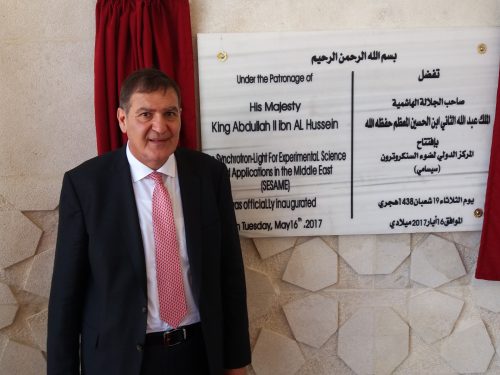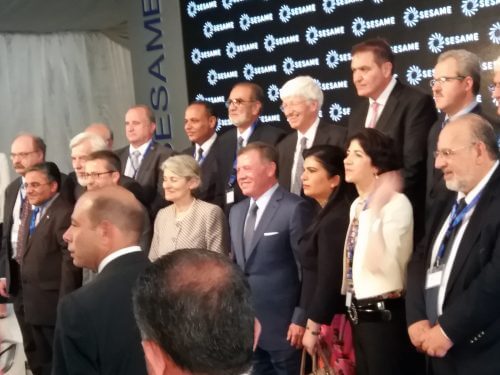"We promote peace through science". After 20 years of establishment, a particle accelerator was inaugurated in Jordan in which Israel, Iran, the Palestinian Authority and Pakistan are partners, among others

While Iran is stirring in Syria and Lebanon, the Americans are trying to start negotiations between Israel and the Palestinians, Turkey is involved on all fronts and the Middle East is abuzz as usual, a parallel universe exists at an hour's drive from Jerusalem and Tel Aviv, where scientists from Israel, Jordan, Egypt, the Palestinian Authority, Iran, Bahrain, Pakistan, Turkey and Cyprus. Representatives of these countries and of many countries and entities from Europe, gathered today at a site near Amman, the capital of Jordan, to officially inaugurate the extraordinary project.
This miracle is called SESAME, sesame in Hebrew, after the seeds that symbolize an important component of the Middle Eastern diet. But the food is only a hint of the real business of scientific collaboration. Here the name is the initials of Synchrotron-Light for Experimental Science and Applications in the Middle East, that is: a light synchrotron for experimental and applied science in the Middle East. The facility is actually a type of particle accelerator, which will soon be used as an innovative research tool in many scientific fields, from medicine to climate research and archaeology.
"After many years, the project is becoming a reality. I am very proud that, despite all the upheavals in the region, we did it, and I am very optimistic about the future," said the director of SESAME, Jordanian physicist Prof. Khaled Toukan, to the Davidson website, shortly after the King of Jordan removed the lot from the sign heralding the inauguration of the scientific facility. "Sesmi's goal from day one was to do science for peace," Prof. Tarek Hussein, a physicist from Cairo University who represents Egypt in the project, told the Davidson website. "This is a historic day. All representatives from all countries can speak a common language, the language of science. Even though the Middle East is a hot and bustling area now a Sesame project can contribute to its cooling and calming of the spirits."
long way
The establishment of the project that was inaugurated today (Tuesday) lasted almost in secret for more than twenty years. The plan for a joint Middle Eastern scientific project began to take shape following the Oslo Accords in 1993, and one of its leaders is Prof. Eliezer Rabinovitch, a theoretical physicist from the Hebrew University and currently head of the National Committee for High Energy and vice president of the CERN Council, which manages the European particle accelerator in which Israel participates. He founded with partners a scientific council for the Middle East, which began to promote the establishment of a regional research facility.
The program received a real boost following the assassination of the Prime Minister of Israel, Yitzhak Rabin, in November 1995. About two weeks after the assassination, the members of the council gathered in Dahab in Sinai, and at the initiative of the Egyptians they honored Zechar Rabin with a moment of silence. "The silence that prevailed then still echoes in my ears," said Rabinovitch not long ago to the "New York Times" newspaper.

The decision that the scientific facility would be a synchrotron was made when Germany decided to donate such a facility that operated in Berlin, and was replaced by a new one following the union between the east of the country and the west. The old device was transferred to Jordan and slowly installed in a compound donated by the kingdom in the town of Alan, northwest of the capital Amman. Today, not many components of the original accelerator remain in the facility, but the German contribution started the process. The construction work took a long time, due to budget difficulties and lack of support from the governments involved. But the scientists persisted, and at the beginning of the year the synchrotron was turned on for the first time. The teaching period should end soon, and the Hanukkah ceremony symbolizes the imminent start of the scientific work. Recently, a "call" was published inviting scientists to submit proposals for experiments at the facility, and dozens of proposals are already piling up on the scientific committee's desk.
standing in line
A synchrotron is a particle accelerator that makes use of a feature that in other facilities is considered a problem. In this accelerator, a beam of electrons moves at a speed close to the speed of light, in a circular path with a circumference of 133 meters. The electrons by nature strive to move in a straight line, and what keeps them in the circular orbit are very strong magnets. The deflection of the beam causes the emission of radiation, and in synchrotrons this radiation is harnessed for scientific research. Additional magnets affect the rays coming out of the circuit, and control the type of radiation: X-rays of different intensities, ultraviolet radiation and even infrared radiation.
"The synchrotron is actually a lamp, a light source, that emits radiation for research purposes. Using radiation, you can identify various biological materials, photograph the structure of materials, look for proteins in cancer cells, and more," explains Prof. Roi Beck-Barkai from Tel Aviv University, the Israeli representative. In the SESAME Users Committee, which includes the representatives of the partner countries in the project. "The radiation in such devices is extremely powerful. In my lab, for example, they study mechanisms related to the creation of complex molecules such as proteins and fats, mainly in the nervous system. We have an advanced X-ray machine in the lab, but these intensities are of completely different orders of magnitude. An experiment that I do in a laboratory with a low resolution in three hours, I can complete in such a facility in ten thousandths of a second, and with a higher resolution."
Facilities like SESAME are not very rare. In fact, there are about 60 of them around the world, none of them in our area. Israeli researchers who wish to use the synchrotron currently have to travel to Western Europe, or even to the United States. Many large studies in the world are done in such facilities, for example all the works based on determining the structure of proteins through crystallography, including that of Ada Yonath, who deciphered the structure of the ribosome.
"The demand for such facilities is much greater than the supply," explains Bek-Barkai. "When I need it for research, I submit an application, and there is a 40-10 percent chance that it will be approved, depending on the nature of the research. In the end, most studies are not carried out because there is no device available. Another advantage is that the facility in Jordan is geographically very close to us."

Peace and silence
Seven research stations are planned at the SESAME facility, which will use different types of radiation, although so far only two have been installed, and a third is expected to start working only in a few months. "The main reason for this is lack of funds," explains Rabinovitch. "We work on a very tight budget. So far, about 100 million dollars have been invested in the construction of the facility, which is a tiny amount compared to such facilities in the world."
The project's source of funding is membership fees paid by the partner countries, several million dollars each, as well as a contribution from the European particle accelerator, CERN, which has sponsored the project in recent years and is trying to help promote it. Israel, one of the initiative countries, has so far paid about NIS 40 million for the project through the Ministry of Science. But Rabinovitch and the other scientists are not letting budget constraints slow them down. "A two-decade effort is now reaching a very important milestone," he says. "Scientists, engineers and public service workers in the various countries managed to take their governments to a place they never thought they would be, and they still don't blink."
"This project is already promoting peace," says director Toukan. "Despite all the events in the region - wars, revolutions and conflicts - the Sesame Council meets twice a year in full composition, and all countries pay their membership fees on time. This is a sign of real commitment."
Despite the blowing winds of peace, politics is still strongly felt. The representatives of Iran, Pakistan and Kuwait refused to talk to ethnic groups who identified themselves as Israelis. However, not to mention many of them praise Israel and the entire project. A Pakistani diplomat who asked not to publish his name and position said "Pakistan and Israel can have good relations. Both countries have advanced technologies and we need scientific ties. Every interaction - official or unofficial - helps promote peace."
In the absence of the Minister of Science, Ofir Akunis, who decided not to come to Jordan due to differences of opinion with Amman, Israel was represented by the director general of the ministry, Peretz Vezan. "Through regional cooperation we hope to strengthen relations with neighboring countries. The scientific cooperation will permeate cooperation in other fields", said Wezan and added "through connections and alliances and by seeking opportunities with our neighbors, we will advance the region together and be ready for the challenges of the 21st century".
In the end, despite the difficulties, there are good relations between the scientists. "Zen is a good opportunity to take our countries in the right direction," concludes Bek-Barkai. "The work between the scientists from the different countries is very productive, and we are showing how it is possible to deal with helping each other, instead of killing each other."
